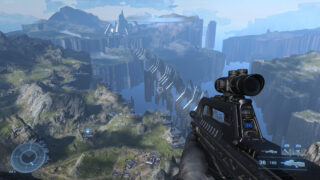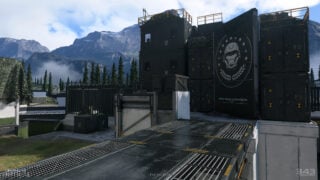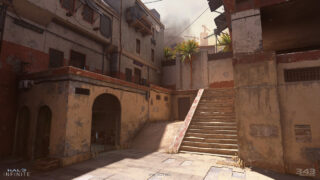Review: Halo Infinite is a return to form for the series
343’s shift to open-world results in a fresh and nostalgic experience, but there’s room for improvement
- Campaign project lead
- Joseph Staten
- Key Credits
- Justin Dinges (Campaign art lead), Jeff Easterling (Narrative lead)

Halo Infinite Campaign review
By Andy Robinson
On paper, Halo in an open-world setup feels like a perfect marriage.
Even though previous Halo entries were very much linear games, their best moments featured sprawling environments, beautiful vistas and the agency to jump in a Warthog and tear off in your own direction. The shift to a large, freeform map potentially offers a world full of Halo’s best bits.
This series has always been about the sandbox and manipulating its sublime combat loops – shoot! Grenade! Punch! – with freedom and panache. Transporting this formula over to an even bigger world with a map, skill tree, activities and all the other trappings of the open-world genre makes so much sense, and in Halo Infinite’s campaign, it’s a mostly compelling evolution.
Infinite opens with one of many nods to the original Combat Evolved, with Master Chief marauding through a linear enemy starship level, concluding with the famous Spartan taking control of the bridge and dispatching many Brutes, Grunts and Jackals along the way.
Soon after, Chief finds himself on the Zeta Halo, a ring world that has been occupied by alien forces known as The Banished. The Chief is flanked by a new AI companion and a cowardly pilot, as he steps out on the seemingly endless stretch of green and blue, and embarks on a campaign of alien massacre and ancient relics.
This time around, players are free to explore the Halo ring in a fairly open structure; there’s a map dotted with upgrades to collect, bases to liberate and high-value targets to assassinate. But developer 343 is keen to emphasise that this isn’t an open-world in the traditional GTA sense: the map isn’t the size of a small city and players are subtly ushered through smaller, manageable chunks of the world to explore, without going too far off course.
Although players are free to take on side activities and explore the wilderness of Zeta Halo, there’s always subtle guidance keeping you within a manageable space, until you’re ready to take on the nearby mega-fortress and progress the story further. The format works well, and it means that you never really feel overwhelmed by the sheer number of things to do on the map, as in other big-world shooters.
By completing side activities, players are rewarded with Valor points. The more of this resource you collect, the more weapons and vehicles you’ll unlock to spawn from the various Forward Operating Bases (FOBs) around Zeta Halo. For the first time, Master Chief also has a skill tree, with various upgrades able to be unlocked using collectable Spartan Cores hidden around the world. This is a great way of encouraging players into the wilderness to improve their equipment, even if it feels like Chief’s powers could’ve benefited from a bit more depth.
The scale of Zeta Halo solves many issues players had with 343’s previous games, Halo 4 and Halo 5: Guardians. The environments – of course – are sprawling, naturalistic and hugely reminiscent of the classic Xbox games, which will please those who found 343’s previous playgrounds to be cramped and artistically disconnected from the series’ roots.
The setup also means that the narrative is less intrusive, relying more on radio chatter and audio logs than 5’s occasionally overbearing cut-scenes (although the cinematic sequences that are here are excellent, with some brilliant performances from Jen Taylor in particular, as Master Chief’s new AI assistant).
“The environments are sprawling, naturalistic and hugely reminiscent of the classic Xbox games, which will please those who found 343’s previous playgrounds to be cramped and artistically disconnected from the series’ roots”
Another wonderful evolution is the introduction of the Grappleshot. Anyone who’s played the multiplayer beta will know how enjoyable and disruptive this mechanic can be, but in single-player it makes even more sense.
Here Chief is able to quickly scale cliffsides and flank enemies by zipping across the battlefield. Grappling also introduces excellent combat dynamics, with players able to grapple towards baddies for a swift melee finish, or pull in a powerful weapon from across the room. The grapple is a perfect fit within Halo’s combat loop and the biggest compliment we can give is that it feels like it should’ve always been there.
The Grappleshot embodies how Infinite carefully balances evolving Halo’s classic formula, while simultaneously retaining elements that made the earlier games memorable.
Capturing FOBs to create fast travel points and reveal nearby side activities feels like a thoroughly contemporary mechanic, but when you spawn in a Warthog, load it with soldiers and scream towards a base manned by an army of Elites, Grunts and Jackals, it feels like you’re back in 2001 and loving every minute.

At one point, the player is tasked with travelling to various POIs around Zeta Halo. While initially, we feared this could be a cynical stretching out of the campaign, it actually ended up being one of the more enjoyable parts of the campaign. Because Halo is at its best when it arranges all of its parts in a multi-course meal; a large-scale battle, a tight indoor siege, an assault course behind the controls of a tank.
All of these great moments – harking back to the natural grandiose of Combat Evolved’s beachhead or Warthog chase moments – take place in the wide-open world, for better or worse.
Exploring Zeta Halo and planning your assault on the nearest Banished base is as good as single-player Halo has been since Bungie handed over the keys. It’s at once both a brilliantly nostalgic and delightfully fresh evolution of the tried-and-tested Halo formula.
But it also feels like a foundation that still has plenty of space for building upon, once its creators are able to produce better-realised ideas.
For example, the main cinematic missions aren’t as strong as time spent outside in the sandbox. It feels like 343 couldn’t quite work out how to elegantly merge them with the free-form outside, and as a result, the story missions feel more like the developer returning to old habits with mostly cramped indoor environments where the player can be easily directed, and a few too many bullet-sponge boss fights.
The skill tree also quickly becomes irrelevant once you’ve maxed out one or two segments, and even when fully maxed out, your character doesn’t feel particularly unique or specialised.
The sandbox is ultimately a tool and Infinite’s campaign feels like it’s only scratching the surface with what Halo could do in such a setting. Significantly, co-op is also not in at launch (and 343 has suggested it could be 6 months before it’s added via a post-launch update) – a feature that would almost certainly thrive here.
There are improvements to be made then, but despite these criticisms, what’s here represents a compelling revival for the Halo series and the best campaign since Bungie handed over the reins.
Halo Infinite multiplayer review
By Jordan Middler
Halo Infinite’s multiplayer suite is excellent, but it also feels like it’s stuck in a generational gap. Not in the sense that it feels like an older game in terms of gameplay, but more in how the multiplayer progression has been structured.
It manages to capture in incredible fun of the early Halo games while shaking off the off-putting esports veneer of the recent 343 entries, but as evidenced by the constant on-the-fly changes to the way multiplayer progression is handled, it doesn’t quite feel as fully baked as it should at release.
The classic game modes are all here, Slayer, Oddball, CTF and more make their Xbox Series X debut, however, due to the way that searching for multiplayer matches works at the time of writing, you may find yourself waiting for a long time in order to play the mode you actually want. There’s no Slayer-only playlist, which in Halo feels like a cardinal sin.
This also creates an issue in team balancing. As there’s no punishment for leaving games, if you happen to matchmake into a mode that you’re not keen on, you can simply leave, and it won’t affect you, however, your team will be left with a bot, and as soon as another member of the team notices this, they’ll leave too.
The moment-to-moment feels incredible, aided by the suite of new equipment that makes Halo Infinite feel like the most agile Halo ever. There’s a whole new level of strategy combining the firing rates and ranges of weapons that have been in Halo since the early 2000s, with a grappling hook that completely changes the dimensions of engagement.
No longer does the slow, lumbering movement speed of Halo feel like a hindrance when travelling long distances, you can zip across the map with ease. Almost every weapon feels viable, and the frequency with which they’re placed around the map, you’ll get a chance to use almost all of them.
Sure, things like the energy sword will be stolen the moment it spawns, but unless you end up playing at a competitive level, it doesn’t feel profoundly imbalanced. It takes skill, but we never found ourselves feeling cheated by an encounter, or wildly outmatched.
“There’s a whole new level of strategy combining the firing rates and ranges of weapons that have been in Halo since the early 2000s, with a grappling hook that completely changes the dimensions of engagement.”
At launch, the battle pass and general progression system feel half baked. There are challenges to complete and rewards to earn, but it feels very dated when compared to something like Fortnite or Warzone.
There are no per-weapon challenge trees to explore, something that would reward players for trying weapons they’re not comfortable with, if you don’t want to play a game mode that’s required for your challenges and you don’t have any swap tokens, you’re pretty much earning the bare minimum per-game XP.
If you have no interest in any of that stuff and you simply want to play the game, regardless of the progression, then you’ll have a brilliant time, and the sheer quality of the action in Halo Infinite’s multiplayer can’t be oversold, but it would be nice if your time spent was better rewarded.
The map selection at launch also isn’t stellar. You’ll quickly find yourself revisiting the same maps over and over, and while they are good, extended sessions will find you and your party sighing at seeing the same neon-drenched streets set the stage for a game of oddball for the 10th time that night.
Halo Infinite's move to a more open-world structure feels like a new beginning for the series, with nostalgic nods and fresh introductions combining to great effect. Both the campaign and multiplayer have room for improvement, but the core experience is strong.
- Exploring Zeta Halo is the best Halo has been since Bungie
- The campaign manages to feel both authentic and fresh
- Multiplayer captures the fun of the early games
- Campaign story missions feel more conventional
- Multiplayer progression could be improved
































